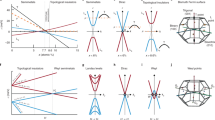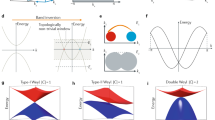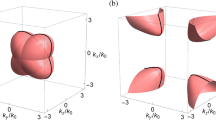Abstract
A Weyl semimetal is a novel topological phase of matter1,2,3,4,5,6,7,8,9,10,11,12,13,14,15,16, in which Weyl fermions arise as pseudo-magnetic monopoles in its momentum space. The chirality of the Weyl fermions, given by the sign of the monopole charge, is central to the Weyl physics, since it directly serves as the sign of the topological number5,15 and gives rise to exotic properties such as Fermi arcs5,9,12 and the chiral anomaly15,16,17,18,19. Here, we directly detect the chirality of the Weyl fermions by measuring the photocurrent in response to circularly polarized mid-infrared light. The resulting photocurrent is determined by both the chirality of Weyl fermions and that of the photons. Our results pave the way for realizing a wide range of theoretical proposals15,16,20,21,22,23,24,25,26,27,28,29,30 for studying and controlling the Weyl fermions and their associated quantum anomalies by optical and electrical means. More broadly, the two chiralities, analogous to the two valleys in two-dimensional materials31,32, lead to a new degree of freedom in a three-dimensional crystal with potential novel pathways to store and carry information.
This is a preview of subscription content, access via your institution
Access options
Access Nature and 54 other Nature Portfolio journals
Get Nature+, our best-value online-access subscription
$32.99 / 30 days
cancel any time
Subscribe to this journal
Receive 12 print issues and online access
$259.00 per year
only $21.58 per issue
Buy this article
- Purchase on SpringerLink
- Instant access to full article PDF
Prices may be subject to local taxes which are calculated during checkout




Similar content being viewed by others
References
Weyl, H. Elektron und gravitation. Z. Phys. 56, 330–352 (1929).
Volovik, G. E. The Universe in a Helium Droplet (Oxford Univ. Press, 2003).
McEuen, P. L. et al. Disorder, pseudospins, and backscattering in carbon nanotubes. Phys. Rev. Lett. 83, 5098–5101 (1999).
Murakami, S. Phase transition between the quantum spin Hall and insulator phases in 3D: emergence of a topological gapless phase. New J. Phys. 9, 356 (2007).
Wan, X., Turner, A. M., Vishwanath, A. & Savrasov, S. Y. Topological semimetal and Fermi-arc surface states in the electronic structure of pyrochlore iridates. Phys. Rev. B 83, 205101 (2011).
Burkov, A. A. & Balents, L. Weyl semimetal in a topological insulator multilayer. Phys. Rev. Lett. 107, 127205 (2011).
Huang, S. M. et al. A Weyl fermion semimetal with surface Fermi arcs in the transition metal monopnictide TaAs class. Nat. Commun. 6, 7373 (2015).
Weng, H. et al. Weyl semimetal phase in non-centrosymmetric transition metal monophosphides. Phys. Rev. X 5, 011029 (2015).
Xu, S.-Y. et al. Discovery of a Weyl fermion semimetal and topological Fermi arcs. Science 349, 613–617 (2015).
Lu, L. et al. Observation of Weyl points in a photonic crystal. Science 349, 622–624 (2015).
Lv, B. Q. et al. Experimental discovery of Weyl semimetal TaAs. Phys. Rev. X 5, 031013 (2015).
Lv, B. Q. et al. Observation of Weyl nodes in TaAs. Nat. Phys. 11, 724–727 (2015).
Yang, L. X. et al. Weyl semimetal phase in the non-centrosymmetric compount TaAs. Nat. Phys. 11, 728–733 (2015).
Belopolski, I. et al. Criteria for directly detecting topological Fermi arcs in Weyl semimetals. Phys. Rev. Lett. 116, 066802 (2016).
Jia, S., Xu, S.-Y. & Hasan, M. Z. Weyl semimetals, Fermi arcs and chiral anomalies. Nat. Mater. 15, 1140–1144 (2016).
Parameswaran, S. A. et al. A. Probing the chiral anomaly with nonlocal transport in three-dimensional topological semimetals. Phys. Rev. X 4, 031035 (2014).
Xiong, J. et al. Evidence for the chiral anomaly in the Dirac semimetal Na3Bi. Science 350, 413–416 (2015).
Zhang, C. et al. Signatures of the Adler–Bell–Jackiw chiral anomaly in a Weyl semimetal. Nat. Commun. 7, 10735 (2016).
Huang, X. et al. Observation of the chiral anomaly induced negative magneto-resistance in 3D Weyl semi-metal TaAs. Phys. Rev. X 5, 031023 (2015).
Chan, C.-K., Lindner, N. H., Refael, G. & Lee, P. A. Photocurrents in Weyl semimetals. Phys. Rev. B 95, 041104 (2017).
Taguchi, K., Imaeda, T., Sato, M. & Tanaka, Y. Photovoltaic chiral magnetic effect in Weyl semimetals. Phys. Rev. B 93, 201202(R) (2016).
Ishizuka, H., Hayata, T., Ueda, M. & Nagaosa, N. Emergent electromagnetic induction and adiabatic charge pumping in Weyl semimetals. Phys. Rev. Lett. 117, 216601 (2016).
Morimoto, T., Zhong, S., Orenstein, J. & Moore, J. E. Semiclassical theory of nonlinear magneto-optical responses with applications to topological Dirac/Weyl semimetals. Phys. Rev. B 94, 245121 (2016).
de Juan, F., Grushin, A. G., Morimoto, T. & Moore, J. E. Quantized circular photogalvanic effect in Weyl semimetals. Preprint at http://arXiv.org/abs/1611.05887 (2016).
Sodemann, I. & Fu, L. Quantum nonlinear Hall effect induced by Berry curvature dipole in time-reversal invariant materials. Phys. Rev. Lett. 115, 216806 (2015).
Chan, C.-K., Lee, P. A., Burch, K. S., Han, J. H. & Ran, Y. When chiral photons meet chiral fermions: photoinduced anomalous Hall effects in Weyl semimetals. Phys. Rev. Lett. 116, 026805 (2016).
Chen, Y., Wu, S. & Burkov, A. A. Axion response in Weyl semimetals. Phys. Rev. B 88, 125105 (2013).
Hosur, P. & Qi, X.-L. Tunable circular dichroism due to the chiral anomaly in Weyl semimetals. Phys. Rev. B 91, 081106(R) (2015).
Goswami, P., Sharma, G. & Tewari, S. Optical activity as a test for dynamic chiral magnetic effect of Weyl semimetals. Phys. Rev. B 92, 161110(R) (2015).
Ma, K. & Pesin, D. A. Chiral magnetic effect and natural optical activity in (Weyl) metals. Phys. Rev. B 92, 235205 (2015).
Xu, X. et al. Spin and pseudospins in layered transition metal dichalcogenides. Nat. Phys. 10, 343–350 (2014).
Mak, K.-F. & Shan, J. Photonics and optoelectronics of 2D semiconductor transition metal dichalcogenides. Nat. Photon. 10, 216–226 (2016).
Zheng, H. et al. Atomic scale visualization of quantum interference on a Weyl semimetal surface by scanning tunneling microscopy/spectroscopy. ACS Nano 10, 1378–1385 (2016).
Inoue, H. et al. Quasiparticle interference of the Fermi arcs and surface-bulk connectivity of Weyl semimetals. Science 351, 1184–1187 (2016).
Batabyal, R. et al. Visualizing ‘Fermi arc’ in the Weyl semimetal TaAs. Sci. Adv. 2, e1600709 (2016).
Yu, R. et al. Determine the chirality of Weyl fermions from the circular dichroism spectra of time-dependent angle-resolved photoemission. Phys. Rev. B 93, 205133 (2016).
Xu, B. et al. Optical spectroscopy of the Weyl semimetal TaAs. Phys. Rev. B 93, 121110(R) (2016).
Wu, L. et al. Giant anisotropic nonlinear optical response in transition metal monopnictide Weyl semimetals. Nat. Phys. 13, 350–355 (2017).
McIver, J. W. et al. Control over topological insulator photocurrents with light polarization. Nat. Nanotech. 7, 96–100 (2012).
Yuan, H. et al. Generation and electric control of spin-valleycoupled circular photogalvanic current in WSe2 . Nat. Nanotech. 9, 851–857 (2014).
Ivchenko, E. L. & Ganichev, S. in Spin Physics in Semiconductors (ed. Dyakonov, M. I.) (Springer, 2008).
Ganichev, S. D. & Prettl, W. Spin photocurrents in quantum wells. J. Phys. Condens. Matter 15, R935–R983 (2003).
Diehl, H. et al. Spin photocurrents in (110)-grown quantum well structures. New J. Phys. 9, 349 (2007).
Gabor, N. M. et al. Hot carrier assisted intrinsic photoresponse in graphene. Science 334, 648–652 (2011).
Herring, P. K. et al. Photoresponse of an electrically tunable ambipolar graphene infrared thermocouple. Nano Lett. 14, 901–907 (2014).
Murray, J. J. et al. Phase relationships and thermodynamics of refractory metal pnictides: the metal-rich tantalum arsenides. J. Less-Common Met. 46, 311–320 (1976).
Perdew, J. P., Burke, K. & Ernzerhof, M. Generalized gradient approximation made simple. Phys. Rev. Lett. 77, 3865–3868 (1996).
Acknowledgements
We thank L. Ye and J. Checkelsky for the help with sample preparation. N.G. and S.-Y.X. acknowledge support from US Department of Energy, BES DMSE, Award number DE-FG02-08ER46521 (initial planning), the Gordon and Betty Moore Foundation’s EPiQS Initiative through Grant GBMF4540 (data analysis), and in part from the MRSEC Program of the National Science Foundation under award number DMR-1419807 (data taking, manuscript writing, and using shared experimental facilities). Work in the P.J.-H. group was partly supported by the Center for Excitonics, an Energy Frontier Research Center funded by the US Department of Energy (DOE), Office of Science, Office of Basic Energy Sciences under Award Number DESC0001088 (fabrication and measurement) and partly through AFOSR grant FA9550-16-1-0382 (data analysis), as well as the Gordon and Betty Moore Foundation’s EPiQS Initiative through Grant GBMF4541 to P.J.-H. P.A.L. acknowledges the support by DOE under grant DE-FG02-03-ER46076 (theoretical analyses). T.P. and Y.L. acknowledge partial funding support from the ONR PECASE project (Award No. 021302-001) and the MIT/Army Institute for Soldier Nanotechnologies (Award No. 023674) (experimental setup). G.C. and H.L. were supported by the National Research Foundation (NRF), Prime Minister’s Office, Singapore, under its NRF fellowship NRF Award No. NRF-NRFF2013-03 (first-principles band structure calculations). C.-L.Z. and S.J. were supported by National Basic Research Program of China (grant Nos. 2013CB921901 and 2014CB239302) (single crystal growth). W.X. was supported by the start-up funding through LSU College of Science (single crystal XRD measurements).
Author information
Authors and Affiliations
Contributions
N.G., P.J.-H., S.-Y.X. and Q.M. designed the experiment. N.G. and P.J.-H. supervised the project. Q.M. and S.-Y.X. performed the measurements and analysed the data. Y.L. and T.P. assisted with the measurements. C.-L.Z. and S.J. grew the single crystal. G.C. and H.L. provided the first-principles band structures. C.-K.C. and P.A.L. provided theoretical analysis and calculated the photocurrents. W.X. performed the single-crystal XRD measurement. S.-Y.X. and Q.M. wrote the manuscript with input from all authors.
Corresponding authors
Ethics declarations
Competing interests
The authors declare no competing financial interests.
Supplementary information
Supplementary information
Supplementary information (PDF 3211 kb)
Rights and permissions
About this article
Cite this article
Ma, Q., Xu, SY., Chan, CK. et al. Direct optical detection of Weyl fermion chirality in a topological semimetal. Nature Phys 13, 842–847 (2017). https://doi.org/10.1038/nphys4146
Received:
Accepted:
Published:
Issue date:
DOI: https://doi.org/10.1038/nphys4146
This article is cited by
-
Broken symmetries associated with a Kagome chiral charge order
Nature Communications (2025)
-
Photogalvanic effects in non-centrosymmetric halide perovskites
Nature Reviews Physics (2025)
-
Chiral Floquet engineering on topological fermions in chiral crystals
npj Quantum Materials (2024)
-
Magnetic, transport and topological properties of Co-based shandite thin films
Communications Physics (2024)
-
Circular photocurrents in centrosymmetric semiconductors with hidden spin polarization
Nature Communications (2024)



